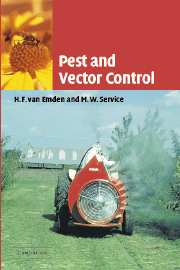Book contents
- Frontmatter
- Contents
- Preface
- 1 Man and insects
- 2 The causes of pest and vectored disease outbreaks
- 3 Insecticides and their formulation
- 4 Application of insecticides
- 5 Problems with insecticides
- 6 Environmental/cultural control
- 7 Biological control
- 8 Insect pathogens
- 9 Genetic control
- 10 Pheromones
- 11 Plant and host resistance
- 12 Other control measures and related topics
- 13 Pest and vector management
- Appendix of names of some chemicals and microbials used as pesticides
- References
- Index
9 - Genetic control
Published online by Cambridge University Press: 03 December 2009
- Frontmatter
- Contents
- Preface
- 1 Man and insects
- 2 The causes of pest and vectored disease outbreaks
- 3 Insecticides and their formulation
- 4 Application of insecticides
- 5 Problems with insecticides
- 6 Environmental/cultural control
- 7 Biological control
- 8 Insect pathogens
- 9 Genetic control
- 10 Pheromones
- 11 Plant and host resistance
- 12 Other control measures and related topics
- 13 Pest and vector management
- Appendix of names of some chemicals and microbials used as pesticides
- References
- Index
Summary
Introduction
Genetic control of pests and vectors is often called autocidal control, except where sterilizing chemicals (chemosterilants, see later) are applied to field populations. Autocidal control is particularly ecologically friendly. This is because, unlike biological control even, nothing alien is introduced into the environment, albeit that the target organism is genetically modified in some way. However, considerable ecological knowledge of the population dynamics of the target pest is usually required, especially as regards mating behaviour and dispersal. Unlike most control strategies the emphasis is not so much on death processes as on reducing birth rates. The target pest must be capable of being cultured and reared in usually enormous numbers, which immediately limits the species that can be candidates for genetic control.
Several techniques have been proposed for genetic control (e.g. hybrid sterility, cytoplasmic incompatibility, chromosomal translocations), but the most widely used and most successful has been the sterile-insect technique (SIT) (sometimes called sterile male technique (SMT) or sterile insect release method (SIRM)). This usually involves the mass release of sterile adult males. The technique is particularly suited for insect species that mate only once or, if there is multiple mating, sperm from the first mating is the sperm that fuses with the eggs. Purists would argue that SIT is not true genetic control because the sterility induced is not inherited, nevertheless it is generally considered a form of genetic control.
- Type
- Chapter
- Information
- Pest and Vector Control , pp. 190 - 203Publisher: Cambridge University PressPrint publication year: 2004



